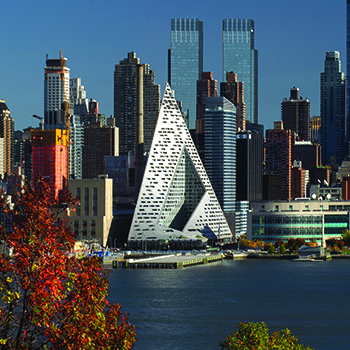Filter by
You must be a CTBUH Member to view this resource.

VIA 57 WEST
Pyramid, West 57th, W57, West57
Building
Completed
2016
Residential
All-Concrete
142.3 m / 467 ft
34
1
709
285
11
77,202 m² / 830,995 ft²
You must be a CTBUH Member to view this resource.
You must be a CTBUH Member to view this resource.
Proposed
Construction Start
Completed
Usually involved in the front end design, with a "typical" condition being that of a leadership role through either Schematic Design or Design Development, and then a monitoring role through the CD and CA phases.
The Engineer of Record takes the balance of the engineering effort not executed by the “Design Engineer,” typically responsible for construction documents, conforming to local codes, etc.
Other Consultant refers to other organizations which provided significant consultation services for a building project (e.g. wind consultants, environmental consultants, fire and life safety consultants, etc).
These are firms that consult on the design of a building's façade. May often be referred to as "Cladding," "Envelope," "Exterior Wall," or "Curtain Wall" Consultant, however, for consistency CTBUH uses the term "Façade Consultant" exclusively.
You must be a CTBUH Member to view this resource.
Usually involved in the front end design, with a "typical" condition being that of a leadership role through either Schematic Design or Design Development, and then a monitoring role through the CD and CA phases.
Usually takes on the balance of the architectural effort not executed by the "Design Architect," typically responsible for the construction documents, conforming to local codes, etc. May often be referred to as "Executive," "Associate," or "Local" Architect, however, for consistency CTBUH uses the term "Architect of Record" exclusively.
The Engineer of Record takes the balance of the engineering effort not executed by the “Design Engineer,” typically responsible for construction documents, conforming to local codes, etc.
The Engineer of Record takes the balance of the engineering effort not executed by the “Design Engineer,” typically responsible for construction documents, conforming to local codes, etc.
The main contractor is the supervisory contractor of all construction work on a project, management of sub-contractors and vendors, etc. May be referred to as "Construction Manager," however, for consistency CTBUH uses the term "Main Contractor" exclusively.
Other Consultant refers to other organizations which provided significant consultation services for a building project (e.g. wind consultants, environmental consultants, fire and life safety consultants, etc).
These are firms that consult on the design of a building's façade. May often be referred to as "Cladding," "Envelope," "Exterior Wall," or "Curtain Wall" Consultant, however, for consistency CTBUH uses the term "Façade Consultant" exclusively.
2016 CTBUH Awards
29 January 2018 - Event
7 September 2017 - Event

29 January 2018 | New York City
The London Committee of the CTBUH United Kingdom Chapter recently hosted [i]Geometry of Tall Buildings[/i], a conversation between leading architects and engineers on the geometry...

08 August 2017
Leading Women in Tall Buildings
Recently, there has been a growing and overdue recognition in the architecture discipline that women are under-represented, not just in terms of leadership positions held,...
VIA 57 West is a housing project designed as a hybrid between the European perimeter block and a traditional Manhattan high-rise. Durst commissioned BIG to bring this new residential typology to Manhattan. It has a unique design to allow for a courtyard and opening the courtyard to views towards the Hudson River.
2016 CTBUH Awards

29 January 2018 | New York City
The London Committee of the CTBUH United Kingdom Chapter recently hosted [i]Geometry of Tall Buildings[/i], a conversation between leading architects and engineers on the geometry...

03 November 2016 | New York City
By incorporating the social sustainability of a mid-rise structure with the efficiency and density of a high-rise, the distinctive massing and appearance of VIA 57...

03 November 2016 | New York City
Kai-Uwe Bergmann, Partner, BIG, and Alexander Durst, Chief Development Officer, The Durst Organization, are interviewed by Chris Bentley regarding VIA 57 WEST, New York City,...

15 April 2016 | New York City
Bjarke Ingels, BIG, discusses new building parameters and how they have influenced the design of two of New York City's most unique projects, 2 World...

27 October 2015 | New York City
With the rise of technological solutions, the practice of architecture is often divorced from the cultural, social, and environmental contexts where we build. Buildings have...

27 October 2015 | New York City
Bjarke Ingels of Bjarke Ingels Group is interviewed by Chris Bentley during the 2015 CTBUH New York Conference at the Grand Hyatt New York. Bjarke...

08 August 2017
Leading Women in Tall Buildings
Recently, there has been a growing and overdue recognition in the architecture discipline that women are under-represented, not just in terms of leadership positions held,...

26 October 2015
Bjarke Ingels, Bjarke Ingels Group
With the rise of technological solutions, the practice of architecture is often divorced from the cultural, social, and environmental contexts where we build. Buildings have...

22 October 2015
CTBUH Research
A timeline of skyscraper completions in New York uncannily resembles the boom and bust cycles of the United States in the 20th and early 21st...

01 December 2012
Bjarke Ingels, Bjarke Ingels Group
OMA alumnus Bjarke Ingels has made a name for his Bjarke Ingels Group with innovative, paradigm-busting projects that blend nature and functionality with new twists...
29 January 2018
The CTBUH UK Chapter recently hosted a conversation between architects and engineers on the geometry of tall buildings and its impact on the design trends of the future.
7 September 2017
The CTBUH Australia Chapter’s Brisbane Committee held the third of its 2017 breakfast seminar series on Queensland Infrastructure.
4 November 2016
The CTBUH Awards Jury named Shanghai Tower, Shanghai as the “2016 Best Tall Building Worldwide” at the 15th Annual CTBUH Awards Ceremony and Dinner.
22 June 2016
CTBUH is proud to announce the winners and finalists for the CTBUH 2016 Tall Building Awards, chosen from a pool of 132 submissions vying for recognition.
27 August 2015
CTBUH New York, in association with the New York Young Professionals Committee hosted an event entitled Skin:NY that focused on high-rise façade design and construction
Subscribe below to receive periodic updates from CTBUH on the latest Tall Building and Urban news and CTBUH initiatives, including our monthly newsletter. Fields with a red asterisk (*) next to them are required.
View our privacy policy